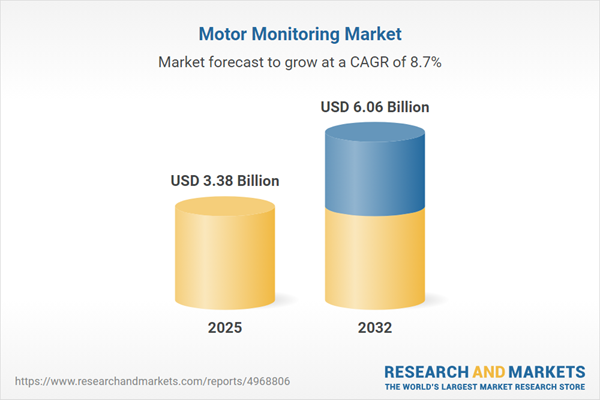Speak directly to the analyst to clarify any post sales queries you may have.
Motor monitoring solutions are transforming how enterprises manage assets by equipping senior leaders with tools to streamline processes, increase operational reliability, and accelerate digital transformation across industrial operations. Leveraging real-time sensor data and advanced analytics, organizations are prepared to adapt to evolving operational demands while maximizing the value of critical equipment.
Market Snapshot: Motor Monitoring Market Growth and Opportunities
The global motor monitoring market is expanding steadily, powered by a rising emphasis on advanced analytics and digital integration within organizations worldwide. Market research reveals that, from 2024 to 2032, businesses are channeling investments into predictive and real-time monitoring platforms to enhance maintenance visibility and curtail equipment downtime. Enhanced insights into asset health support more agile management of essential machinery, driving operational continuity and reducing interruptions. Compliance and regulatory frameworks are shaping the deployment of scalable motor monitoring technologies equipped for a changing regulatory environment. For industries reliant on continuous production and reliable infrastructure, intelligent monitoring technologies offer essential protection and operational assurance.
Scope & Segmentation of the Motor Monitoring Market
This report provides decision-focused intelligence on the factors shaping motor monitoring strategies and global technology adoption. Senior stakeholders gain actionable understanding of current technology choices and their implications across sectors and geographies.
- Offering: Modular hardware, including sensor-based solutions, actively tracks real-time parameters such as current, temperature, vibration, and ultrasound readings. These systems support services tailored to both on-site and remote diagnostic needs for a broad range of operational contexts.
- Technique: Techniques such as vibration analysis, thermal monitoring, acoustic sensing, and ultrasound detection offer early identification of motor performance deviations. This supports scalable, condition-based maintenance and enhances risk management approaches for complex assets.
- Motor Type: Monitoring systems are adaptable across a variety of motors, including induction, synchronous AC, brushed DC, and brushless DC models, enabling deployment from manufacturing plants to large commercial sites.
- Deployment: Solution models include cloud-based, on-premise, and portable options, enabling organizations to align monitoring infrastructures with specific site, process, or enterprise requirements.
- End Use: Industries such as automotive, chemicals, oil and gas, manufacturing, and power generation benefit from monitoring solutions that strengthen compliance efforts and maximize asset utilization.
- Regions: Market intelligence encompasses the Americas, Europe, Middle East and Africa, and Asia-Pacific, facilitating regional strategies and supporting localized investment planning as adoption drivers vary by geography.
- Key Companies: Leading motor monitoring technology providers recognized for innovation include ABB Ltd, Siemens AG, Emerson Electric Co., Rockwell Automation Inc., General Electric Company, Honeywell International Inc., SKF AB, Danaher Corporation, Fortive Corporation, and National Instruments Corporation.
Key Takeaways: Strategic Insights in Motor Monitoring Technologies
- Internet of Things (IoT)-enabled and edge-connected motor monitoring devices simplify predictive maintenance for executive management, enhancing resource allocation and reliability across industrial environments.
- The combination of ultrasound and thermal sensory techniques delivers higher precision in asset oversight, improving lifecycle management and reducing unexpected equipment failures.
- Increased connectivity among motor monitoring platforms, industrial IoT, and overarching asset management systems accelerates access to data-driven insights, supporting quicker operational decision-making.
- Automated diagnostic tools coupled with compliance monitoring streamline adherence to evolving regulatory standards, fostering stronger risk management practices.
- Flexible infrastructure options, accommodating both centralized and distributed asset supervision, facilitate standardized monitoring across diverse site portfolios and operations.
- Adoption of motor monitoring solutions supports organizational digital transformation, equipping companies with resilience and adaptability to meet new industry requirements.
Tariff Impact and Supply Chain Resilience
- Recent changes in U.S. tariff policy have encouraged enterprises to broaden sourcing strategies, increasing procurement agility and reinforcing supply chain resilience during market fluctuations.
- Rising logistics expenses drive organizations to evaluate nearshoring and adopt modular procurement models, ensuring reliable access to components and reducing vulnerabilities in supply chain management.
Research Methodology & Data Sources
This market analysis combines comprehensive secondary research with direct contributions from industry specialists and solution vendors. Findings reflect peer-reviewed, validated data to support decision-making confidence for senior leaders.
Why This Report Matters for Senior Decision-Makers
- Supports seamless integration of motor monitoring with enterprise digital initiatives to reinforce asset resilience and business continuity planning.
- Offers focused insight into technology choices, regulatory navigation, and procurement optimization within dynamic market environments.
- Empowers executives with recommendations for managing evolving operational requirements, ensuring readiness and strategic foresight.
Conclusion
Adopting motor monitoring strategies enables organizations to proactively strengthen performance, secure essential assets, and respond efficiently to emerging industry shifts. These initiatives establish a sound platform for sustainable operational success.
Additional Product Information:
- Purchase of this report includes 1 year online access with quarterly updates.
- This report can be updated on request. Please contact our Customer Experience team using the Ask a Question widget on our website.
Table of Contents
3. Executive Summary
4. Market Overview
7. Cumulative Impact of Artificial Intelligence 2025
Companies Mentioned
The companies profiled in this Motor Monitoring market report include:- Emerson Electric Co.
- ABB Ltd
- Siemens AG
- Rockwell Automation Inc.
- General Electric Company
- Honeywell International Inc.
- SKF AB
- Danaher Corporation
- Fortive Corporation
- National Instruments Corporation
Table Information
| Report Attribute | Details |
|---|---|
| No. of Pages | 190 |
| Published | November 2025 |
| Forecast Period | 2025 - 2032 |
| Estimated Market Value ( USD | $ 3.38 Billion |
| Forecasted Market Value ( USD | $ 6.06 Billion |
| Compound Annual Growth Rate | 8.7% |
| Regions Covered | Global |
| No. of Companies Mentioned | 11 |









